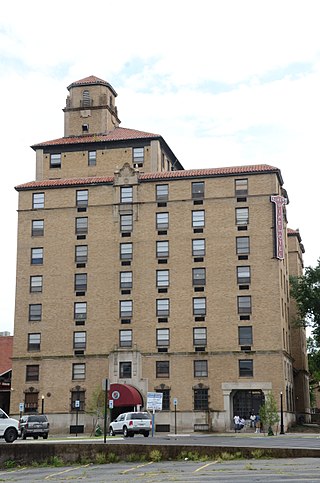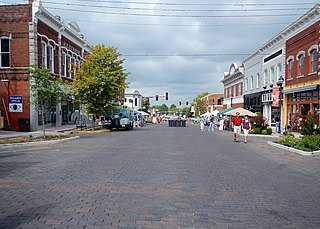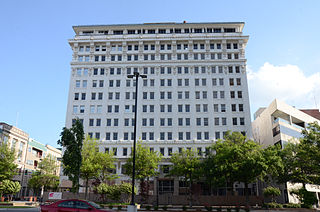Shiloh or Shilo may refer to:

The Albert Pike Residence Hotel is a historic commercial building at 701 South Scott Street in Little Rock, Arkansas.

Located near Dardanelle, Arkansas and rising about 1,350 feet (410 m) above the mountain valleys of west-central Arkansas to an elevation of about 1,755 feet (535 m) above sea level, Mount Nebo has views of 34,000 acres (140 km2) Lake Dardanelle, the Arkansas River and the surrounding mountain ridges. Atop this biblically named plateau is Mount Nebo State Park. Developed as a resort area in the late 19th century, it became a state park in 1928, its early development spearheaded by the Civilian Conservation Corps. Park activities include hiking, camping, and other outdoor pursuits.

U.S. Route 64 is a U.S. highway running from Teec Nos Pos, Arizona east to Nags Head, North Carolina. In the U.S. state of Arkansas, the route runs 246.35 miles (396.46 km) from the Oklahoma border in Fort Smith east to the Tennessee border in Memphis. The route passes through several cities and towns, including Fort Smith, Clarksville, Russellville, Conway, Searcy, and West Memphis. US 64 runs parallel to Interstate 40 until Conway, when I-40 takes a more southerly route.

The Rogers Commercial Historic District, known informally as Historic Downtown Rogers, is a historic district in the central business district of Rogers, Arkansas. When it was first listed on the National Register of Historic Places in 1988, it was known as the Walnut Street Historic District; this was changed when the district was enlarged in 1993. The district encompasses a portion of the city's central business district, whose historical significance extends from about 1885 to the end of World War II.

George Richard Mann was an American architect, trained at MIT, whose designs included the Arkansas State Capitol. He was the leading architect in Arkansas from 1900 until 1930, and his designs were among the finalists in competitions for the capitols of several other states.
The University of Arkansas Campus Historic District is a historic district that was listed on the National Register of Historic Places on September 23, 2009. The district covers the historic core of the University of Arkansas campus, including 25 buildings.

The Sid Hutcheson Building is a historic commercial building at 13912 Arkansas Highway 5 in the center of Norfork, Arkansas. Built c. 1910, it is a vernacular two-story structure, built out of local stone and concrete. The west-facing facade is dominated by a two-story porch extending the full width of the building. The building is divided into three storefronts, which housed a grocery story, a Ford dealership, and a hotel, when it was completed. It is one of six commercial buildings, and is representative of the community's growth after the arrival of the railroad in the early 20th century.

The Hotel Seville is a historic hotel building at Vine and Ridge Streets in downtown Harrison, Arkansas. It is an L-shaped three story wood-frame structure, finished in brick and terra cotta veneer with distinctive Spanish Revival (Mission) styling. Its eastern entry porch is supported by polychrome terra cotta pillars, and portions of the exterior are finished in terra cotta tile with inset geometric patterns. Built in 1929, the building is one of the most elaborate examples of Spanish Revival architecture in the state. It was used as a hotel until the mid-1970s, when it was converted to elderly housing. It has since been converted back to a hotel.

The Commercial Hotel is a historic hotel building facing the courthouse square of Mountain View, Arkansas. It is a two-story wood-frame structure, rectangular in plan, with a hip roof that has exposed rafter ends, and weatherboard siding. A porch wraps around its principal facades, supported by box columns. Built in 1925, it is a fine local example of commercial Craftsman architecture, and one of two surviving hotel buildings from the 1920s in the community.

The Woodmen of Union Building is a historic commercial building at 501 Malvern Avenue in Hot Springs, Arkansas. It is a four-story structure, built mainly out of brick and ceramic blocks, although its southeastern section has upper levels with wood framing and finishing. Its main facade has an elaborate projecting entrance portico, with the entrance set in an elliptical-arch opening supported by fluted pilasters. The interior retains significant original features, including a bank vault, marble wainscoting, and a 2,500-seat auditorium. It was built in 1923-24 for the Supreme Lodge of the Woodmen of Union, an African-American social organization, which operated it as a multifunction bathhouse, hotel, hospital, bank, and performance venue. It was purchased in 1950 by the National Baptist Association.

The Capitol–Main Historic District encompasses a well-preserved area of early 19th-century commercial architecture in downtown Little Rock, Arkansas. The district includes 2-1/2 blocks of Capitol Street, extending east from Center Street, one block of Main Street south of Capitol, and one block of 6th Street west of Main. The buildings in this area were mostly built before World War II, and are of a more modest scale than modern sections of the downtown. Notable buildings include the LaFayette Hotel and the Pfeifer Brothers Department Store.

The Hotel Pines is a historic commercial building at the northwest corner of West 5th and Main Streets in Pine Bluff, Arkansas. It is a large six-story U-shaped masonry structure, with a two-story section filling the center of the U. The center section has a portico projecting over the sidewalk, with Classical Revival detailing and paired columns for support. Built in 1913 and in operation as a hotel until 1970, it was Pine Bluff's grandest hotel.

The Pine Bluff Commercial Historic District encompasses a portion of the historic city center of Pine Bluff, Arkansas. It extends from Barraque Street south along Main Street, extending in places to properties alongside streets. The area's commercial development began about 1840, when the courthouse square was laid out at Barraque and Main, and proceeded through the early 20th century. Most of the commercial properties of the district were built between 1880 and 1910, and are reflective architecturally of late 19th-century commercial building styles.

The former LaFayette Hotel is a historic commercial building at 525 South Louisiana Street in downtown Little Rock, Arkansas. It is a twelve-story concrete structure, faced primarily in brick. It has a rectangular footprint at its base, with an L-shaped tower facing the street fronts of South Louisiana and Sixth Street. Its facades are decorated with terra cotta panels, and it is crowned by a pressed metal cornice. Its main entrances are marked by projecting marquees of cast iron. The hotel was designed by St. Louis architect George Barnett and was built in 1925. The hotel operated until 1933, opening again after World War II until closing in 1973.

The former Castleberry Hotel is a historic commercial building at 61 Main Street in De Valls Bluff, Arkansas. It is a two-story masonry structure, built out of brick and capped by a hip roof whose eaves have exposed rafter tails. A porch extends across the sidewalk in front of the building, supported by brick piers. Built in 1925, it is a good local example of Craftsman architecture. It was the town's principal hotel, serving through travelers until the 1960s, when the town was bypassed by interstate highways.
The Sims Hotel was a historic hotel in Plumerville, Arkansas. Located in the town center, it was the last surviving remnant of the town's early heyday as a railroad community. Built in 1860s as a private residence, it was converted to a hotel when the railroad arrived in the 1870s, and was decorated with then-fashionable Gothic gingerbread trim on its two-story porch. It was the only railroad-oriented hotel to survive fires that swept the city's downtown in the early 20th century.
The Liberty Schoolhouse, also known as the Mt. Grove School, is a historic schoolhouse in a remote part of Ozark-St. Francis National Forest in Logan County, Arkansas. It is east of Corley, Arkansas, near the junction of Valentine Spring and Copper Spring Roads. It is a single-story vernacular wood-frame structure, with a gabled roof, weatherboard siding, and a foundation of concrete block piers. It was built in 1897, and was used by the community as both a school and church. It served as a school until 1944, and also hosted civic meetings and social events.

The Aristocrat Motor Inn is a historic hotel building at 240 Central Avenue in Hot Springs, Arkansas. It is a large seven-story structure, with a six-story U-shaped tower set on a basically rectangular ground floor. It is finished in glass, brick, and metal, in the Mid-Century Modern style. The tower is organized around a central courtyard, with the interior facades in a sawtooth pattern to maximize light coming into the hotel rooms facing inward. The hotel was built in 1963 by Samuel Kirsch, a local businessman engaged in a variety of pursuits. It was one of the first hotels built along the city's Central Avenue to feature a Modernist exterior. It was operated as a hotel until 1978, and was after converted into low-income housing.

The Manhattan Hotel in Salida, Colorado, at 225 F St., was built in 1901. It served as a hotel until the 1930s, and went vacant after the railroad closed, then was opened intermittently. It was listed on the National Register of Historic Places in 1983.


















